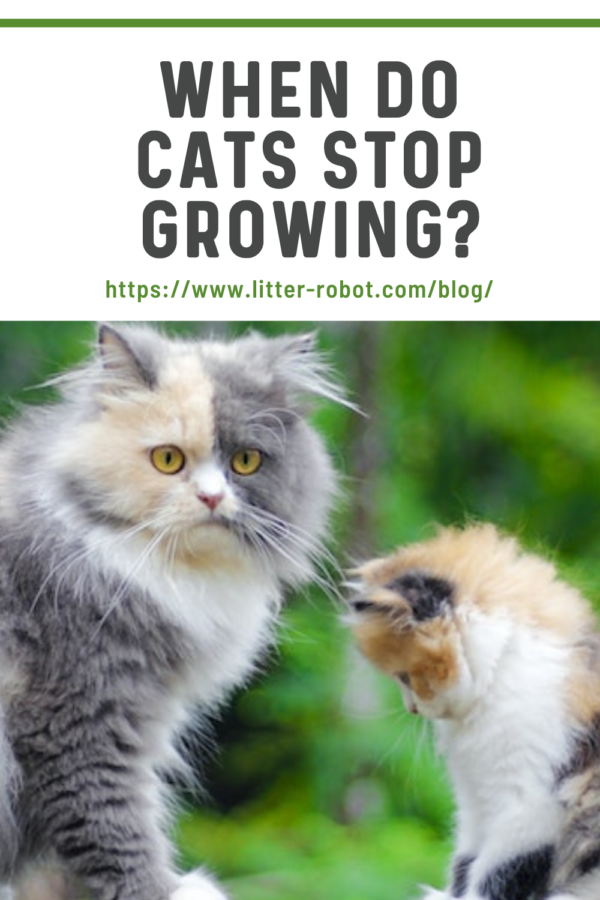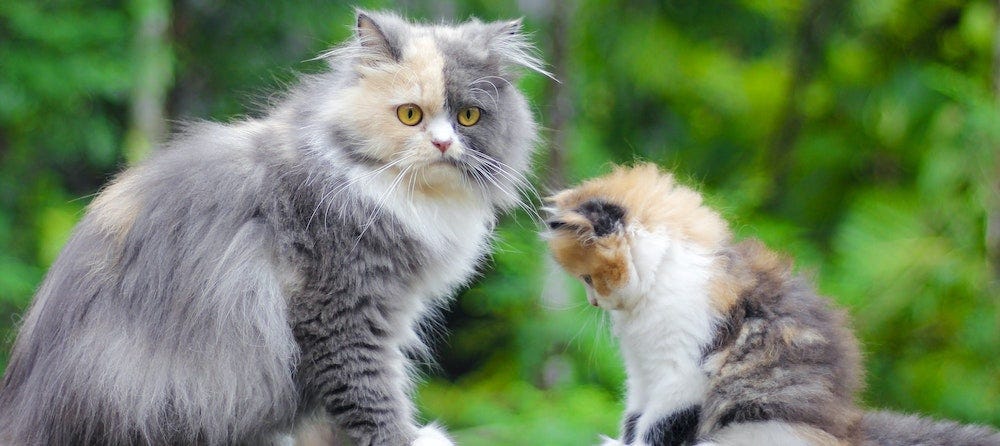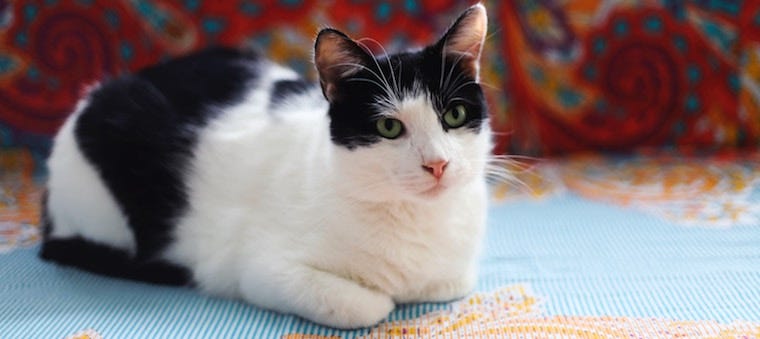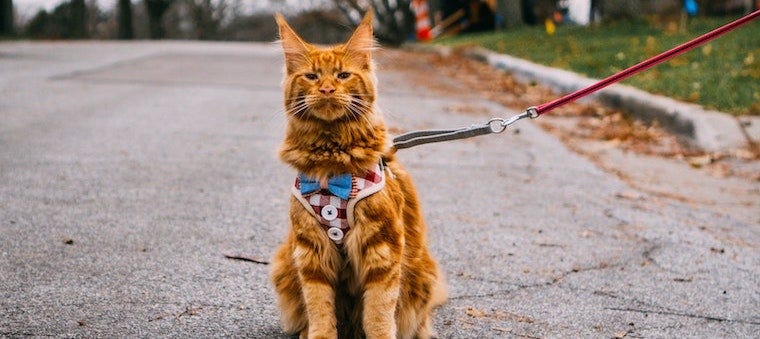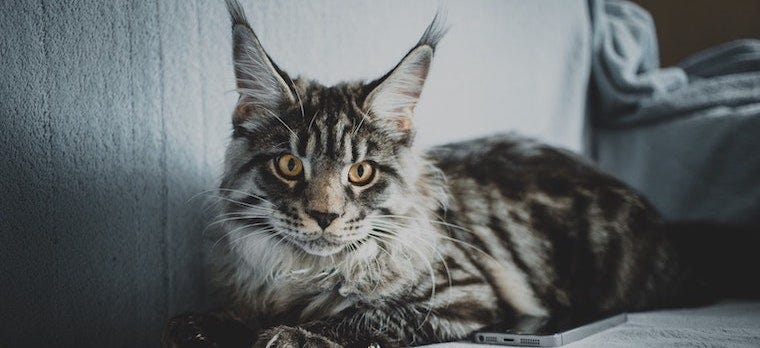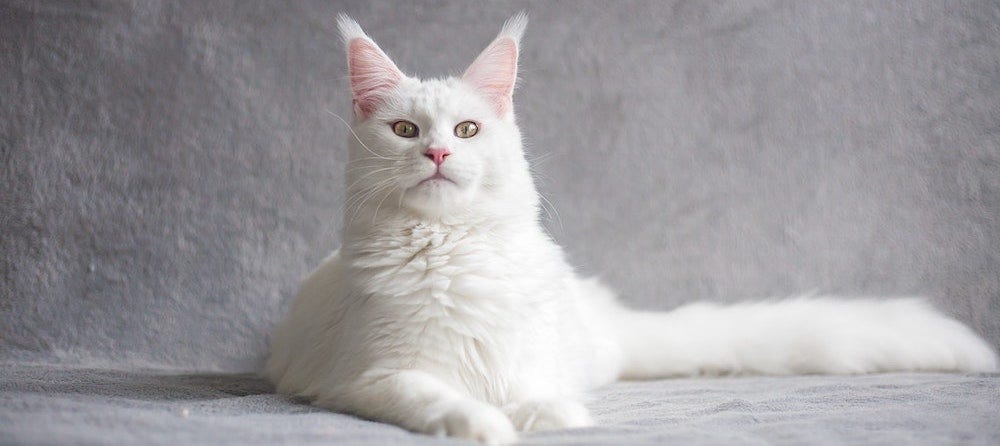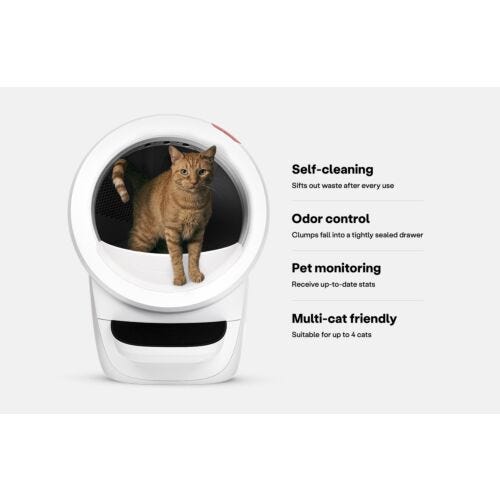Are your kitten’s ears too big for their face, or their paws too big for their body? Those are sure signs that they have some more growing to do!
But when do cats stop growing? There actually isn’t a simple answer to that question. Depending on their breed, cats reach full maturity at different ages. Read on to learn about when cats typically stop growing, and which breeds take longer to reach full maturity.
When are cats considered adults?
There are multiple stages to kitten growth, but veterinarians consider cats to be “adults” when they are 1 year or older. This means that by your kitten’s first birthday, they should be eating adult cat food. (Preferably, you’ll begin transitioning a little before their first birthday.)
Unfortunately, female kittens can go into their first heat cycle as young as 4-5 months of age—which means kittens are capable of carrying kittens. That’s why you should spay and neuter your cats early!
When do cats stop growing – typically?
Even if your cat is considered an adult at 1 year of age, does that mean they have stopped growing? Ask veterinarians “When do cats stop growing?” and you’ll likely receive answers that range from 9 months old to 2 years old.
Kittens grow the most in the first 6 months of life. In fact, healthy kittens grow 8 times their size in just about 8 weeks! By approximately 1 year old, cats will weigh at or around their adult weight, which typically ranges from 7 to 15 pounds depending on the breed. Of course, that doesn’t include cats that become overweight. (Sadly, 60-70% of cats in the U.S. are considered overweight to obese.)
Some cats take years to reach their full size
While the typical house cat stops growing around 1 year old, certain cat breeds take years to reach full maturity. Cats of these breeds tend to be larger (although that isn’t always the case) than the average domestic cat.
Additionally, it is true that lots of people like to know how long their particular breed of cat will take to reach their adult size. The truth of the matter is that very little research has been conducted to determine these particular factors by scientists. Many of the numbers come from breeders and cat breed enthusiasts, not veterinarians or dedicated research. These numbers are what are generally accepted for each of the breeds to come.
American Bobtail

The American Bobtail cat takes up to 3 years to reach full maturity. This naturally occurring short-tailed cat is well-muscled and solid with powerful hind legs, allowing them to jump up to 6 feet high. Their wild appearance is very recognizable, partly because they often display tabby patterns similar to those of wild bobcats. They can have either short hair or long hair that may appear dense and thick or long and shaggy.
This breed is sometimes called the “golden retriever” of the cat world because they want to please their humans and stay by their side as much as possible. Plus, they can adapt easily to their human’s environment—whether it’s a small apartment, an RV, a boat, you name it!
Birman

Birman cats also reach their full (medium to large) size at around 3 years old. Their bodies are elongated but slightly compact. This breed sports a silky colorpoint coat that is semi-long to long in length. Birmans are known for their white paws and deep sapphire eyes, which will help you understand why this cat was once worshiped.
The Birman is a loving, gentle, and inquisitive pal. If you have big groups over or live in an apartment with neighbors, your Birman won’t mind one bit. Instead, they will be excited and anticipate the next time everyone comes to visit them—they are the life of the party!
Maine Coon

The Maine Coon is one of the largest cat breeds. Unsurprisingly, it takes time to reach their full size—2 to 3 years, in fact, with other sources citing as long as 3 to 5 years. A typical weight range for Maine Coons is 10-18 pounds, but they can reach up to 25 pounds. Their length is perhaps even more impressive, ranging around 30-40 inches (and even breaking world records at 48.5 inches long!).
The Maine Coon is a large cat with long fur that makes them appear even bigger. They are also affectionate and loyal to their families. You can feel confident having your children or other pets around your Maine Coon, because they are highly adaptable and easygoing.
Manx

The Manx cat, which is bred to be tail-free, doesn’t reach their full size until 5 years of age. While typically medium-sized, their solid body and thick, short coat aid in their reputation for thriving on the Isle of Man where they originated.
Like the Maine Coon, Manx cats are natural mousers. When they’re not on guard, they are generally mellow and people-oriented. They are adaptable, affectionate companions that should be adopted or rescued, rather than purchased from a breeder.
Norwegian Forest cat
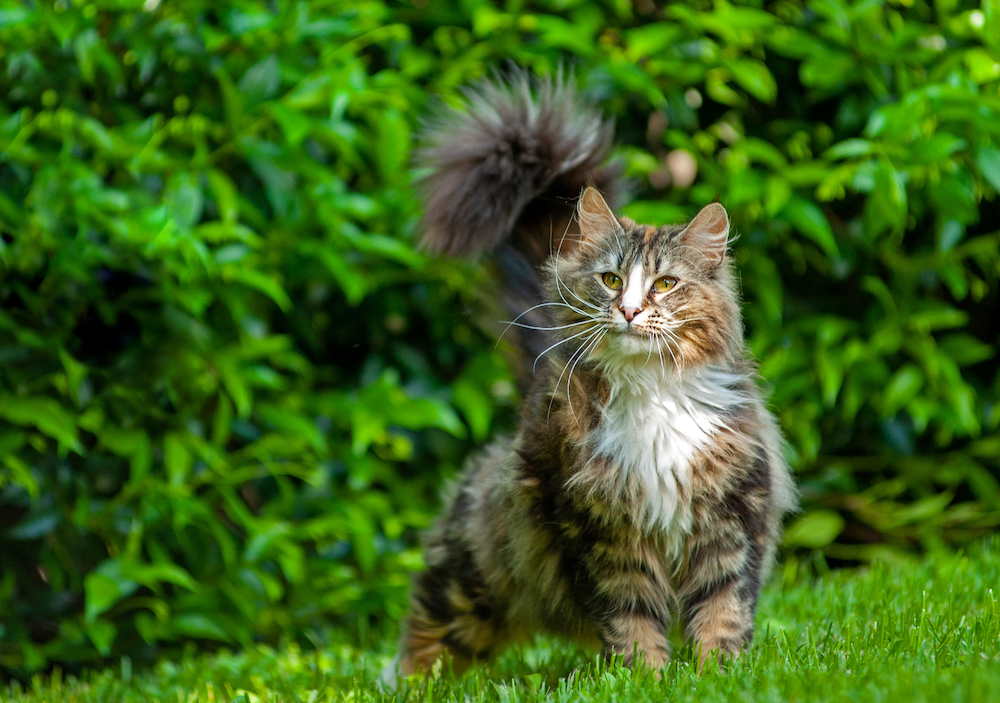
The stunning yet rugged Norwegian Forest cat attains full growth at around 5 years old. When fully grown, their weight ranges between 8 and 20 pounds. They are a sturdy breed with a very muscular body, which helped them to thrive in the wild for centuries. Now their strength is used to pounce on lasers, climb cat trees, and chase after gleeful children.
As the official cat of Norway, this breed has been mentioned in Scandinavian legends and mythology. In fact, some say these cats traveled with Vikings, keeping their ships and villages free of vermin.
Ragdoll
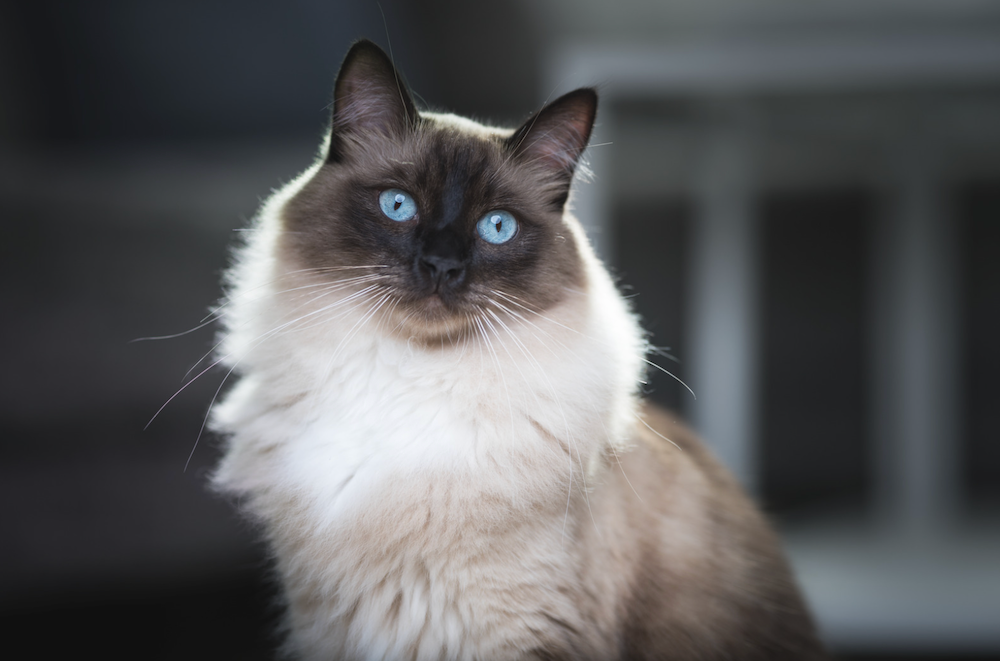
Ragdoll cats are considered the gentle giants of the cat world. These fluffy cats take up to 4 years to reach physical maturity and full weight, which ranges from 10 to 20 pounds. Ragdolls have striking and long colorpoint coats that make them appear even larger than they are, along with beautiful blue eyes.
These “puppycats” are known to collapse into the arms of anyone who holds them, and prefer to stay on the same level in the room as their humans. Their slow maturity pays off with a long average lifespan as well, as a Ragdoll’s life expectancy is up to 17 years.
Ragamuffin

Cousin to the Ragdoll, Ragamuffin cats also take years to fully mature. They tip the scales at around the same weight as Ragdolls, and are pretty similar in most other regards. Their biggest difference? Ragamuffins can display any coat color or pattern. Ragamuffin kittens are all born white; as they mature, their color and pattern begin to develop. It’s exciting to see your blank canvas of a kitten blossom into a beautiful and unique-looking cat!
Ragamuffins are cuddly and personable; they’ll get along great with all members of your household and can adapt easily to meeting new people.
Savannah

The exotic Savannah cat was bred by crossing a domestic cat with an African Serval. This spotted cat can grow very large (around 25 pounds) and live a long life (20 years or more!), thus speaking to their slower rate of maturity. They’re also one of the tallest domestic cat breeds, breaking records with heights of 19 inches or more.
Note, these impressive stats mostly relate to “F1” Savannah cats—those that are only one generation removed from their wild parentage. Many states only allow Savannahs of “F4” or later generations. No matter their filial rating, Savannah cats are energetic, intelligent, and adventurous.
Siberian

The Siberian cat is one of the oldest cat breeds, with references dating back at least 1,000 years. These powerful, long-haired cats take up to 5 years to reach their large size. They are a resilient and strong breed that are known for their very sweet expressions. While they may have been protectors in their past lives, these cats make fantastic family pets and sidekicks.
Siberians are intelligent, affectionate cats with lots of personality. They may get into trouble if they are bored—for example, if they want to get into the closed cabinet, it’s likely they will figure out a way to get in.
Turkish Van

The Turkish Van is a large, agile cat known for a love of playing in water. This breed also takes 3 to 5 years before fully grown. Most of their weight comes from their athletic build, which sports strong muscles that help propel them forward and upward (and likely aids in their reputation as “Swimming Cats.”)
This rare, ancient breed is considered a treasure in its homeland of southeastern Turkey, and is not readily available to export to other countries. Their cashmere-like coats can range in colors but will usually display what’s called the Van pattern: an all-white body with coloring (often orange or cream) on the face or tail.
So, when do cats stop growing? And when do kittens become cats? Now you know there’s no easy answer! While the average cat is done growing between 9 months and 2 years of age, there are many cat breeds that keep growing well beyond that.
Sources:
Cover photo by Nihal Karkala on Unsplash
